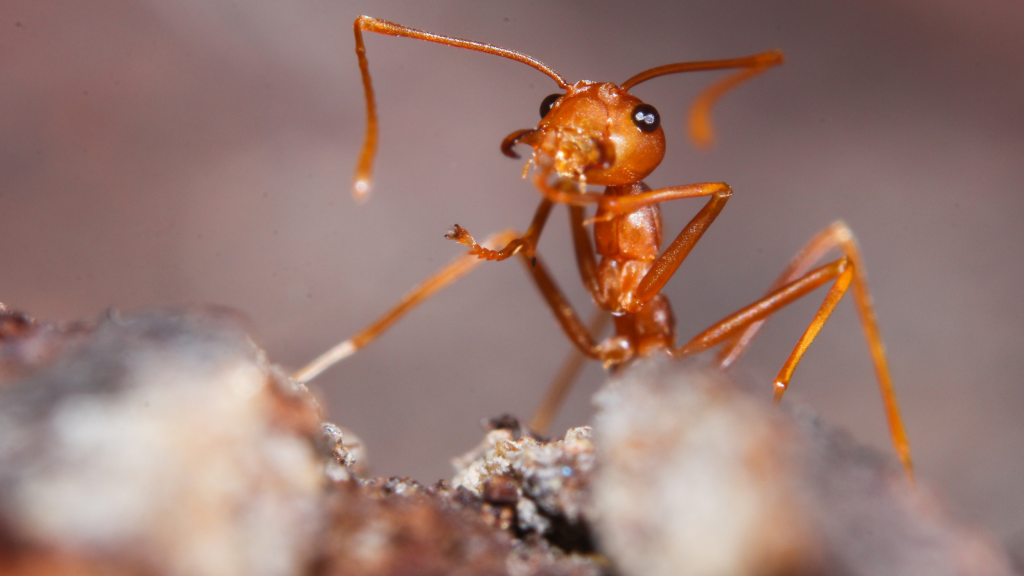
Fire Ants…Tiny Ants, Big Bite
Contrary to common belief, fire ants are extremely different from a regular ant that is found inside your home. Discover their life, differences from other ants, and effective methods to keep them away from your yard!
About Fire Ants
Fire ants are commonly identified by their reddish brown color, distinct 3 part bodies, and venom-filled stinger that is extremely painful. Their stings can cause a burning sensation, intense pain, swelling, and in some cases allergic reactions. They also feed on a variety of foods like insects, seeds, fruits, and even pet waste. Fire ants create dome-shaped mounds in soil typically in open sunny areas like lawns, fields, and parks. Within these colonies, there are thousands, if not hundreds of thousands of ants, with a single queen responsible for reproducing and worker ants responsible for foraging and defending the colony. They will use their painful stinger to protect their colony if disturbed and will be aggressive.
Life Cycle and Roles
Fire ants have multiple stages in their life cycle, and once that is complete they go into different positions within their colony. Here are those different stages:
- Egg – Fire ant eggs are small, oval-shaped, white, and translucent and laid by the queen of the colony within the mound. For the egg to hatch, it all depends on the temperature and humidity and could take days or weeks.
- Larva – Once the egg hatches, it is a larva, which is a legless, grub-like creature with a soft whitish body. They are heavily dependent on the adult workers of the colony to feed them, while they undergo multiple stages of growth and molt their exoskeleton as they grow.
- Pupa – Once the larvae stage is complete, they are pupae, in which they are just inactive and enclosed in cocoons. They undergo metamorphosis, and this stage is most important as this is where they develop their features.
- Adult – Once metamorphosis is complete, they emerge from the cocoons as full-grown adults. Depending on the type of fire ant, they may or may not have wings, and will go into their role within the colony.
Once these fire ants complete their life cycle, they have different positions to fulfill within the colony:
- Queen – Reproductive female that is responsible for laying eggs. They are typically larger than other ants and have wings that are used during mating.
- Male-winged ants whose only purpose is to mate with the queen. They don’t participate in taking care of the colony and usually die after mating.
- Workers – Sterile females with multiple roles in a colony like foragers responsible for searching for food, nurses responsible for taking care of the eggs and the rest of the life cycle, and soldiers responsible for protecting the colony and usually the aggressors stinging anyone trying to mess with the colony.
Impacts and Risks
Fire ants are responsible for a lot more damage than people seem to think. This includes damage to the ecosystem like undermining soil stability, damage to sidewalks and roads, and can cause safety hazards. They can also be a danger to humans and pets, as even getting close to their colony will cause them to become aggressive and then incredibly painful sting.
Fire ants are also extremely invasive in natural areas like forests, grasslands, and wetlands which can then lead to the killing of plants or pests like spiders and other invertebrates. This then leads to long-term ecological impacts and creates a cycle of extreme changes in our environment.
Prevention Tips
- Maintain yard maintenance – Fire ants will use anything in your yard to hide, nest, and sustain themselves, so eliminating these sources will create an environment that they will not be in. Mowing the lawn, removing pet waste, and leaf debris, and reducing moisture are some ways to keep fire ants away.
- Monitor property – Keep a watchful eye on any activity happening at your home to prevent any activity from multiplying and getting worse. Watching for signs like ant mounds, foraging trails, and visible ants as early detection will prevent an infestation.
- Pest Control – Get a licensed company out to your home to have an effective treatment done. With our service, we have created a treatment specifically targeted towards fire ants with a product that will decrease the activity. Our technicians are trained to inspect and do a treatment that is best for your home.
Want to learn more about keeping your home safe from fire ants? Contact our office at (844)572-0628 and get your first service scheduled today!
